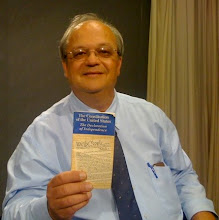This is a diagram of an advanced reactor designed to both produce electricity and hydrogen. The NRC presentation which discusses the design is available at http://www.nuclear.com/archive/2009/04/14/Next_Generation_Nuclear_Plant-NRC-20090414-ML091030059.pdf.
Tuesday, April 14, 2009
Thursday, April 9, 2009
Nuclear plant construction time can be cut 10 months by new Korea Hydro steel plate concrete method
Korea Hydro & Nuclear Power Co. (KHNP) claims their new steel plate concrete building method may reduce overall construction time by 10 months while saving 200 billion won ($147US million) for every two 1,400 megawatt reactor units built. South Korea plans to build eight new reactors by 2016 -- all of them are to use this construction method. A commercial reactor usually takes seven years to build at a cost of trillions of won, depending on power output.
The state-run company said the PC method uses prefabricated sections made by two steel plates embedded with "studs" that are made at factories and shipped to the construction site. Once they are in place, concrete is poured into the space between the plates to form solid walls. "This method is safer, faster, reduces environmental pollution and can be used in the construction of industrial plants and other facilities," a KHNP spokesperson said. The official said the new method was roughly two years ahead of similar research being conducted abroad.
In the past, contractors relied solely on the reinforced concrete method to make specially designed walls at nuclear power plants that required steel reinforcement bars to be built in place, molds to be set up to outline walls, and the space created by the molds filled with cement.
[Source: Yonhap News, "S. Korea develops process to cut time, cost to build nuke reactor", April 9, 2009]
The state-run company said the PC method uses prefabricated sections made by two steel plates embedded with "studs" that are made at factories and shipped to the construction site. Once they are in place, concrete is poured into the space between the plates to form solid walls. "This method is safer, faster, reduces environmental pollution and can be used in the construction of industrial plants and other facilities," a KHNP spokesperson said. The official said the new method was roughly two years ahead of similar research being conducted abroad.
In the past, contractors relied solely on the reinforced concrete method to make specially designed walls at nuclear power plants that required steel reinforcement bars to be built in place, molds to be set up to outline walls, and the space created by the molds filled with cement.
[Source: Yonhap News, "S. Korea develops process to cut time, cost to build nuke reactor", April 9, 2009]
Hillary Clinton's assessment seems a little off on Iran
"There is nothing more important than trying to convince Iran to cease its efforts to obtain a nuclear weapon." That is a quote from Secretary Clinton in article from Jerusalem Post today. Your humble nuclear.com editor disagrees with her take. It's not the trying that's most important, it's the succeeding.
Yucca Mountain - a breathtaking view
I'm 54 years old. If I were paid a tenth of a cent for every breath I've taken so far, that would come to about $430-thousand. I mention that because electricity customers have been paying an extra tenth-of-a-cent for each kilowatt-hour produced by nuclear power since 1983. The extra money goes into a federal government account called the Nuclear Waste Fund, which is dedicated to the task of disposing of the spent fuel. There's been a lot of electricity produced by these hundered-and-some plants over the years. The tenth-of-a-cent charges have totalled to some $30-billion. Almost half has been spent already, on Yucca Mountain, without a single spent fuel bundle yet put in the big hole we've dug. And our federal government leaders don't seem inclined to ever let Yucca Mountain be used for that purpose. I know with all the trillions of dollars being printed to bailout, er rescue, er stimulate, a triflingly few billions wasted doesn't seem so breathtaking any more. More's the pity.
Nuclear power allows Vermont to emit less air pollution in a year than Wyoming does in a day
"Vermont Yankee provides nearly all of Vermont’s electricity, making it the cleanest state in the country. (Coal-rich Wyoming emits more air pollution in a day than Vermont produces in a year.)"
Source: William Tucker, "Go Ahead, Close Oyster Creek", planet gore blog (National Review Online), April 9, 2009
Mr. Tucker just published a book titled Terrestrial Energy: How Nuclear Power Will Lead the Green Revolution and End America’s Energy Odyssey. His article title about closing Oyster Creek is not because he thinks shutdown is warranted, but because New Jersey would be so hurt by shutdown that the resultant howling and gnashing would be instructive the rest of the country.
Source: William Tucker, "Go Ahead, Close Oyster Creek", planet gore blog (National Review Online), April 9, 2009
Mr. Tucker just published a book titled Terrestrial Energy: How Nuclear Power Will Lead the Green Revolution and End America’s Energy Odyssey. His article title about closing Oyster Creek is not because he thinks shutdown is warranted, but because New Jersey would be so hurt by shutdown that the resultant howling and gnashing would be instructive the rest of the country.
Labels:
air pollution,
coal,
nuclear power,
vermont,
wyoming
Subscribe to:
Comments (Atom)
